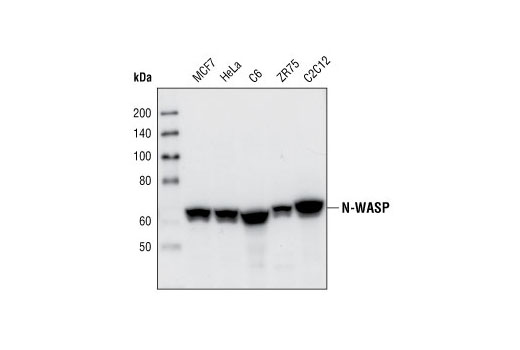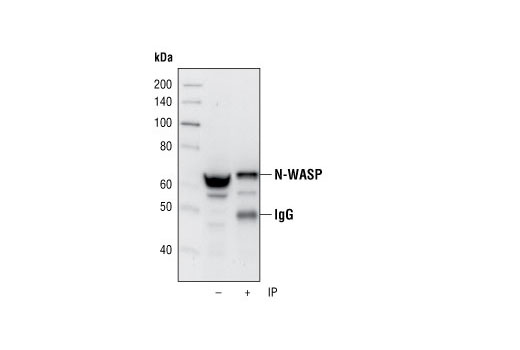WB, IP
H M R Hm Mk B
Endogenous
65
Rabbit
#O00401
8976
Product Information
Product Usage Information
| Application | Dilution |
|---|---|
| Western Blotting | 1:1000 |
| Immunoprecipitation | 1:50 |
Storage
Specificity / Sensitivity
Species Reactivity:
Human, Mouse, Rat, Hamster, Monkey, Bovine
Source / Purification
Monoclonal antibody is produced by immunizing animals with a synthetic peptide corresponding the sequence of human N-WASP.
Background
Wiskott-Aldrich syndrome proteins (WASPs) mediate actin dynamics by activating the Arp2/3 actin nucleation complex in response to activated Rho family GTPases. In mammals, five WASP family members have been described. Hematopoietic WASP and ubiquitously expressed N-WASP are autoinhibited in unstimulated cells. Upon stimulation they are activated by cdc42, which relieves the autoinhibition in conjunction with phosphatidyl inositol 4,5-bisphosphate. Three WAVE (Wasf, SCAR) family proteins are similar in sequence to WASP and N-WASP but lack the WASP/N-WASP autoinhibition domains and are indirectly activated by Rac (reviewed in 1). Both WASP and WAVE functions appear to be essential, as knockout of either N-WASP or Scar-2 in mice results in cardiac and neuronal defects and embryonic lethality (2,3). Loss of WASP results in immune system defects and fewer immune cells (4). WAVE-2 (WASF2) is widely distributed, while WAVE-1 and WAVE-3 are strongly expressed in brain (5). WAVE-3 may act as a tumor suppressor in neuroblastoma, a childhood disease of the sympathetic nervous system (6). Increased expression of WAVE-3 is seen in breast cancer, and studies in breast adenocarcinoma cells indicate that WAVE-3 regulates breast cancer progression, invasion and metastasis through the p38 mitogen-activated protein kinase (MAPK) pathway (7,8).
- Millard, T.H. et al. (2004) Biochem J. 380, 1-17.
- Yan, C. et al. (2003) EMBO J. 22, 3602-3612.
- Snapper, S.B. et al. (2001) Nat. Cell Biol. 3, 897-904.
- Zhang, J. et al. (1999) J. Exp. Med. 190, 1329-4132.
- Suetsugu, S. et al. (1999) Biochem. Biophys. Res. Commun. 260, 296-302.
- Sossey-Alaoui, K. et al. (2002) Oncogene 21, 5967-5974.
- Sossey-Alaoui, K. et al. (2005) Exp. Cell Res. 308, 135-145.
- Sossey-Alaoui, K. et al. (2007) Am J Pathol 170, 2112-21.
Species Reactivity
Species reactivity is determined by testing in at least one approved application (e.g., western blot).
Western Blot Buffer
IMPORTANT: For western blots, incubate membrane with diluted primary antibody in 5% w/v nonfat dry milk, 1X TBS, 0.1% Tween® 20 at 4°C with gentle shaking, overnight.
Applications Key
WB: Western Blotting IP: Immunoprecipitation
Cross-Reactivity Key
H: human M: mouse R: rat Hm: hamster Mk: monkey Vir: virus Mi: mink C: chicken Dm: D. melanogaster X: Xenopus Z: zebrafish B: bovine Dg: dog Pg: pig Sc: S. cerevisiae Ce: C. elegans Hr: horse GP: Guinea Pig Rab: rabbit All: all species expected
Trademarks and Patents
Limited Uses
Except as otherwise expressly agreed in a writing signed by a legally authorized representative of CST, the following terms apply to Products provided by CST, its affiliates or its distributors. Any Customer's terms and conditions that are in addition to, or different from, those contained herein, unless separately accepted in writing by a legally authorized representative of CST, are rejected and are of no force or effect.
Products are labeled with For Research Use Only or a similar labeling statement and have not been approved, cleared, or licensed by the FDA or other regulatory foreign or domestic entity, for any purpose. Customer shall not use any Product for any diagnostic or therapeutic purpose, or otherwise in any manner that conflicts with its labeling statement. Products sold or licensed by CST are provided for Customer as the end-user and solely for research and development uses. Any use of Product for diagnostic, prophylactic or therapeutic purposes, or any purchase of Product for resale (alone or as a component) or other commercial purpose, requires a separate license from CST. Customer shall (a) not sell, license, loan, donate or otherwise transfer or make available any Product to any third party, whether alone or in combination with other materials, or use the Products to manufacture any commercial products, (b) not copy, modify, reverse engineer, decompile, disassemble or otherwise attempt to discover the underlying structure or technology of the Products, or use the Products for the purpose of developing any products or services that would compete with CST products or services, (c) not alter or remove from the Products any trademarks, trade names, logos, patent or copyright notices or markings, (d) use the Products solely in accordance with CST Product Terms of Sale and any applicable documentation, and (e) comply with any license, terms of service or similar agreement with respect to any third party products or services used by Customer in connection with the Products.

